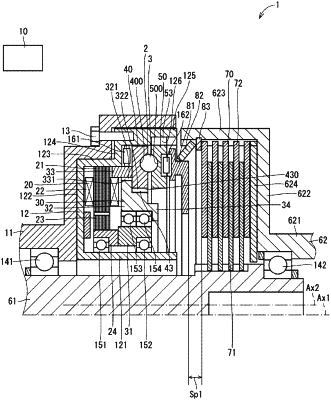| CPC F16D 13/52 (2013.01) [F16D 23/12 (2013.01); F16H 25/12 (2013.01); F16D 2023/123 (2013.01); F16D 28/00 (2013.01)] | 6 Claims |

|
1. A clutch device comprising:
a first transmitter;
a drive device that includes two winding sets and is configured to output torque through energization of the two winding sets;
a drive cam that has a plurality of drive cam grooves formed at one end surface of the drive cam, wherein the drive cam is configured to be rotated by the torque outputted from the drive device;
a plurality of rolling elements that are rotatably installed in the plurality of drive cam grooves, respectively;
a driven cam that has a plurality of driven cam grooves formed at one end surface of the driven cam while each of the plurality of rolling elements is clamped between a corresponding one of the plurality of drive cam grooves and a corresponding one of the plurality of driven cam grooves, wherein the driven cam cooperates with the drive cam and the plurality of rolling elements to form a rolling element cam, and when relative rotation is made between the driven cam and the drive cam, the driven cam is moved relative to the drive cam in an axial direction;
a second transmitter that is configured to transmit the torque between the first transmitter and the second transmitter; and
a clutch that is configured to shift an operational state of the clutch to a coupled state or a decoupled state depending on a relative position of the driven cam relative to the drive cam in the axial direction, wherein the clutch is configured to enable transmission of the torque between the first transmitter and the second transmitter through the clutch in the coupled state and disable the transmission of the torque between the first transmitter and the second transmitter through the clutch in the decoupled state, wherein:
each of the plurality of drive cam grooves includes:
a normal-time drive cam groove that extends from a corresponding drive cam specific point, which is defined as a specific point of the drive cam, toward one side in a circumferential direction of the drive cam, wherein a groove bottom at the normal-time drive cam groove is sloped relative to the one end surface of the drive cam such that a depth of the groove bottom continuously decreases from the corresponding drive cam specific point toward the one side in the circumferential direction of the drive cam; and
an emergency-time drive cam groove that extends from the corresponding drive cam specific point toward another side in the circumferential direction of the drive cam, wherein the groove bottom at the emergency-time drive cam groove is sloped relative to the one end surface of the drive cam such that the depth of the groove bottom continuously decreases from the corresponding drive cam specific point toward the another side in the circumferential direction of the drive cam, and a slope angle of the groove bottom of each of the plurality of drive cam grooves relative to the one end surface of the drive cam is set such that the slope angle of the groove bottom at the emergency-time drive cam groove is smaller than the slope angle of the groove bottom at the normal-time drive cam groove; and
each of the plurality of driven cam grooves includes:
a normal-time driven cam groove that extends from a corresponding driven cam specific point, which is defined as a specific point of the driven cam, toward one side in a circumferential direction of the driven cam, wherein a groove bottom at the normal-time driven cam groove is sloped relative to the one end surface of the driven cam such that a depth of the groove bottom continuously decreases from the corresponding driven cam specific point toward the one side in the circumferential direction of the driven cam; and
an emergency-time driven cam groove that extends from the corresponding driven cam specific point toward another side in the circumferential direction of the driven cam, wherein the groove bottom at the emergency-time driven cam groove is sloped relative to the one end surface of the driven cam such that the depth of the groove bottom continuously decreases from the corresponding driven cam specific point toward the another side in the circumferential direction of the driven cam, and a slope angle of the groove bottom of each of the plurality of driven cam grooves relative to the one end surface of the driven cam is set such that the slope angle of the groove bottom at the emergency-time driven cam groove is smaller than the slope angle of the groove bottom at the normal-time driven cam groove.
|